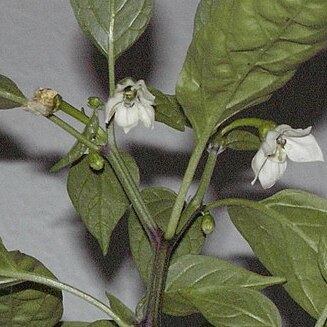Shrubs or annual or perennial herbs; pubescence of simple hairs. Stems branched. Leaves solitary or paired, petiolate; leaf blade simple, entire or sinuate. Inflorescences solitary or few-flowered clusters at branch forks or leaf axils; peduncle absent. Flowers nodding or erect, actinomorphic. Pedicel erect or nodding. Calyx broadly campanulate to cup-shaped, denticulate, sometimes slightly enlarged. Corolla white, blue, or violet, campanulate or rotate, divided halfway or more. Stamens inserted near distal end of corolla tube; filaments slender; anthers yellow or purplish, ovoid, dehiscing longitudinally. Ovary 2-(or 3)-locular; ovules numerous. Style slender; stigma small, capitate. Fruit a moist berry, sometimes large, erect, nodding, or reflexed. Seeds yellowish, discoid; embryo coiled, subperipheral.
Erect or spreading herbs or short-lived, soft-wooded shrubs, glabrous or sparsely pubescent with simple hairs. Leaves alternate or paired, simple, entire, petiolate. Flowers solitary or a few in leaf axils and stem forks, bisexual, actinomorphic. Calyx shortly tubular, with 5 minute teeth, or teeth absent. Corolla stellate in Australian material, white, greenish-white or pale blue; limb deeply 5-lobed, the lobes valvate in bud. Stamens 5, equal in height, inserted at base of corolla-tube; anthers bilocular, connivent, basifixed, dehiscing by longitudinal slits. Ovary bilocular; stigma capitate. Fruit a berry, dryish or somewhat fleshy. Seeds reniform to sub-orbicular.
Seeds numerous, small, flat, compressed, suborbicular or ± reniform, with thickened margin; testa reticulate-rugose or almost smooth; embryo strongly curved or circinnate, subperipheral in the abundant, fleshy endosperm; radicle terete, as wide as the semi-terete cotyledons.
Ovary 2(4)-locular; ovules hemicampylotropous, numerous in each locule, on a placenta adnate to the dissepiment or arising from the central angle of 2 dissepiments at the base; style filiform; stigma capitate or slightly dilated, obsoletely 3-lobed or difformed.
Fruit a berry, extremely variable in size and shape, seated on a flat or cupular calyx and greatly exceeding it, juiceless or somewhat juicy, incompletely 2–3(or rarely 1)-locular, sometimes with large air spaces in the locules, usually acrid.
Corolla purple to bluish, yellowish, white or greenish, sometimes spotted, rotate to widely campanulate; tube short; limb plicate, deeply 5(7)-lobed, the lobes never overlapping in bud, with induplicate-valvate or valvate aestivation.
Leaves alternate, often 2 or 3 appearing together, mainly towards the ends of branches, abruptly or gradually tapering into a slightly winged petiole, mostly entire, to weakly dentate; minor leaves sometimes present.
Calyx short, broadly campanulate to shortly tubular, 5(7)-ribbed, truncate, entire or 5(7)-or 10-dentate; teeth short, setaceous, often splitting at the sutures; in fruit usually slightly enlarged.
Stamens 5(7), variously inserted in the corolla tube, ± exserted; anthers oblong or cordate, connivent or free, basifixed, the ± parallel thecae dehiscing by longitudinal slits.
Annual or short-lived perennial herbs, rarely shrubby, often ± divaricately branched, unarmed, glabrous or pubescent with simple eglandular or glandular hairs.
Flowers 1–few, extra-axillary, leaf-opposed or appearing axillary, actinomorphic.
Disk inconspicuous or none.

